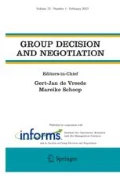Abstract
The Graph Model for Conflict Resolution constitutes a unique and flexible approach to the representation, analysis, and understanding of strategic conflict. This methodology, as implemented in the Decision Support System GMCR, constitutes a useful tool for negotiation support. Because GMCR includes efficient algorithms for calculating the stability of states, it encourages extensive comparisons of the consequences of different models of negotiators' decision making. GMCR also facilitates modifications to the way in which the conflict is represented, encouraging sensitivity and what-if analyses. The applicability of GMCR to negotiations is discussed in general, and in the context of a specific case study in environmental conflict resolution.
Similar content being viewed by others
References
Bergmann-Baker, U. (1991). “Groundwater Contamination and the Restoration of a Hazardous Waste Site in Elmira, Ontario—Relevance of Public Participation in Environmental Decision-Making.” Master's thesis, Universität des Saarlandes, Saarbrücken, Germany.
BramsS. J. (1993).Theory of Moves. Cambridge, U.K.: Cambridge University Press.
BramsS. J., and D.Wittman (1981). “Nonmyopic Equilibria in 2×2 Games,”Conflict Management and Peace Science 6, 39–62.
Burtt, B. (1991). “Halt Cleanup Deal, Region Says.”Kitchener-Waterloo Record, Kitchener, Ontario, Canada, November 2.
Burtt, B. (1993). “Deal Made.”Kitchener-Waterloo Record, Kitchener, Ontario, Canada, March 13.
Crowley, K. (1991). “Uniroyal Agrees to Elmira Cleanup.”Kitchener-Waterloo Record, Kitchener, Ontario, Canada, October 8, p. A1.
Crowley, K., and C. Thompson (1991). “Region Kept Apprised of Uniroyal Cleanup Talks, Grier Says.”Kitchener-Waterloo Recora, Kitchener, Ontario, Canada, October 9.
FangL., K. W.Hipel, and D. M.Kilgour (1989). “Conflict Models in Graph Form: Solution Concepts and Their Interrelationships,”European Journal of Operational Research 41, 86–100.
FangL., K. W.Hipel, and D. M.Kilgour. (1993).Interactive Decision Making: The Graph Model for Conflict Resolution. New York: Wiley.
FraserN. M., and K. W.Hipel. (1979). “Solving Complex Conflicts.”IEEE Transactions on Systems, Man, and Cybernetics, SMC-9, 805–817.
FraserN. M., and K. W.Hipel. (1984).Conflict Analysis: Models and Resolutions. New York: North-Holland.
Hipel, K. W., L. Fang, D. M. Kilgour, and M. Haight. (1993a). “Environmental Conflict Resolution Using the Graph Model.” InProceedings of the IEEE International Conference on Systems, Man, and Cybernetics, Vol. 1, Le Touquet, France, October 17–20, pp. 17–20.
Hipel, K. W., L. Fang, and D. M. Kilgour. (1993b). “Game Theoretic Models in Engineering Decision Making,”Journal of Infrastructure Planning and Management, Japan Society of Civil Engineers 470/IV-20, 1–16.
HowardN. (1971).Paradoxes of Rationality. Cambridge, MA: MIT Press.
IEEE (Institute of Electronic and Electrical Engineers). (1991).Proceedings of the IEEE International Conference on Systems, Man, and Cybernetics, Vol. 3, Charlottesville, Virginia, October 13–16, pp. 1978–2022.
IEEE (Institute of Electronic and Electrical Engineers). (1993).Proceedings of the IEEE International Conference on Systems, Man, and Cybernetics, Vol. 1, Le Touquet, France, October 17–20, pp. 132–158.
KilgourD. M. (1984). “Equilibria for Far-sighted Players,”Theory and Decision 16, 135–157.
KilgourD. M. (1985). “Anticipation and Stability in Two-person Noncooperative Games.” In M. D.Ward and U.Luterbacher (eds.),Dynamic Models of International Conflict. Boulder, CO: Lynne Rienner Press, pp. 26–51.
Kilgour, D. M., L. Fang, and K. W. Hipel. (1994). “The Decision Support System GMCR and the Management of Strategic Uncertainty.” InProceedings of the Fifth International Conference on Information Processing and the Management of Uncertainty, Paris, France, July 4–8, pp. 638–643.
KilgourD. M., K. W.Hipel, and L.Fang. (1987). “The Graph Model for Conflicts,”Automatica 23(1), 41–55.
Mittelstaedt, M. (1991). “Uniroyal to Do Cleanup.”The Globe and Mail, Toronto, Ontario, Canada, October 9.
NashJ. F. (1950). “Equilibrium Points inn-person Games.”Proceedings of National Academy of Science of the U.S.A. 36, 48–49.
NashJ. F. (1951). “Noncooperative Games.”Annals of Mathematics 54(2), 286–295.
RadfordK. J., K. W.Hipel, and L.Fang. (1994). “Decision Making under Conditions of Conflict,”Group Decision and Negotiation 3, 169–185.
SageA. P. (1991).Decision Support Systems Engineering. New York: Wiley.
SinghM. G., and L.Travé-Massuyès, eds. (1991). “Decision Support Systems and Qualitative Reasoning.”Proceedings of the IMACS International Workshop on Decision Support Systems and Qualitative Reasoning, Toulouse, France, March 13–15. Amsterdam: North-Holland, pp. 101–137.
vonNeumannJ., and O.Morgenstern. (1953).Theory of Games and Economic Behavior, 3rd ed. Princeton, NJ: Princeton University Press.
ZagareF. C. (1984). “Limited-move Equilibria in 2×2 Games,”Theory and Decision 16, 1–19.
Author information
Authors and Affiliations
Rights and permissions
About this article
Cite this article
Kilgour, D.M., Fang, L. & Hipel, K.W. Negotiation support using the Decision Support System GMCR. Group Decis Negot 5, 371–383 (1996). https://doi.org/10.1007/BF02404641
Issue Date:
DOI: https://doi.org/10.1007/BF02404641




